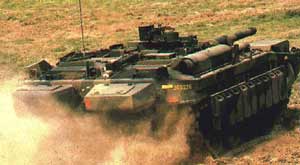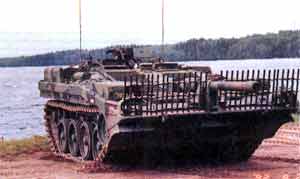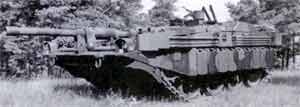| Designation: | Strv 103C |
 |
|---|---|---|
| Manufacturer: | Bofors Defence AB | |
| Product type: | Armoured Vehicles | |
| Name: | Main battle tank |
The Stridsvagn 103 MBT, also known as the S-tank, was developed from 1958 under the leadership of Bofors. Details of the development history were given in Jane's Armour and Artillery 1997-98, pages 114 to 115.
The first Strv 103s were completed in 1966 and production continued until June 1971 by which time 300 had been built. The first production vehicles, known as the Strv 103A, were not fitted with a flotation screen or dozer blade. Later production vehicles, known as the Strv 103B, had both the flotation screen and the dozer blade and earlier production tanks were subsequently brought up to Strv 103B standard.
With the introduction of the German Leopard 2A4 and the Swedish version of the Leopard 2A5 (Strv 122) MBT, the Bofors Strv 103s are now being phased out of service and by the end of this decade will all have gone.
As the S-tank is now being phased out of service there will be no further improvements to this vehicle.
The all-welded steel hull of the S-tank has the engine and transmission at the front, fighting compartment in the centre and magazines at the rear. There is a series of horizontal ribs on the glacis plate to deflect armour-piercing rounds. The two engines are geared together to a common output and the diesel is normally used all the time with the gas turbine being used only when the tank is in action. The gas turbine can be used to assist in cold weather starting and also acts as a power source when the diesel engine is not operating. Two fire extinguishers in the engine compartment can be operated from inside or outside the vehicle. The glacis plate and the main armament have to be removed before the engine can be changed, which takes about 4 hours.
The transmission consists of a Bofors three-step automatic main gearbox with forward and reverse function in bevel gear. Steering is a regenerative double-differential system with a hydrostatic steering device, and is accomplished by handlebars on the tiller columns.
The driver, who also lays and fires the main armament, is seated on the left side of the hull and is provided with a single-piece hatch cover, a OP-1L combined periscope and binocular sight to his front and a single periscope to the left. The OP-1L has a field of view of 100° and a magnification ofx1,x6, x10orx18 with the sight graticule being in the right eyepiece. A SIMRAD LV300 laser range-finder is incorporated into the OPS-1L sight. The radio operator seated to the rear of the driver is provided with a single-piece hatch cover and two periscopes, and controls to drive backwards if required. The commander is seated on the right side of the tank, slightly to the rear of the radio operator and is provided with four periscopes and a OPS-1 combined periscope and binocular sight. The sight is not operated with a laser range-finder, but line-up needles are provided in the left eyepiece. The commander's OPS-1 unit is fully stabilised in elevation from -11 to +16°, and his cupola can be traversed through 208°. The cupola is stabilised in azimuth and enables the commander to locate the target. He then uses the handlebars on the tiller columns to lay the tank onto the target, selects the type of ammunition and then fires the main armament. All the periscopes and sights on the S-tank have armoured shutters which have two functions: they provide a measure of protection against shell splinters and prevent the tank's position being given away by the sun glinting on its periscopes. There is a hull escape hatch in the fighting compartment.
The hydropneumatic suspension system consists of four dual rubber-tyred roadwheels identical to those used on the Centurion MBT, with the idler at the rear, drive sprocket at the front and two track-return rollers. To provide a more stable firing platform the suspension is locked when the main armament is fired. The first and fourth roadwheels are mounted on leading arms with the second and third on trailing arms. A positive displacement pump transfers fluid between the front and rear units, while a servo system compensates for the alteration in the length of track in contact with the ground, and the height of the hull above the ground. The track is of the double pin type with replaceable rubber pads. The original steel tracks have been replaced by Diehl tracks with 122 rubber pads and end connectors.
Main armament of the S-tank is a 105 mm rifled tank gun 62 calibres long designated the L74. The gun, which has a bore evacuator but no muzzle brake, is basically a longer version of the British Royal Ordnance L7 series gun. The gun is fed from a magazine at the rear of the hull which holds 50 rounds of ammunition in 10 racks each holding five rounds. Atypical load would comprise 25 APFSDS, 20 HE and five smoke rounds, but any combination is possible. The automatic loader enables a high rate up to 15 rds/min to be achieved. When all the ammunition has been expended the magazines are reloaded through two hatches at the rear by the crew in about 10 minutes. The empty cartridge cases are automatically ejected outside the hull and if the automatic loading system fails the radio operator can hand crank ammunition to the breech of the gun. Buttons on the main tiller box are used to select the type of ammunition to be fired. Sweden has adopted the Israeli M111 APFSDS-T round for the S-tank as the replacement for the APDS round originally used.
Two fixed 7.62 mm Ksp 58 machine guns mounted on the left side of the hull are laid in a similar mannerto the main armament and fired alternately. Once ammunition has been expended, they have to be reloaded by one of the crew leaving the vehicle. A 7.62 mm Ksp 58 machine gun mounted on the left of the commander's cupola can be aimed and fired from within the vehicle and can also be used for anti-aircraft defence. For target illumination at night two Bofors Lyran launchers are fitted on the roof.
A dozer blade is carried folded under the nose of the tank and when required is swung forward and secured by two rods. It is operated by adjusting the hydropneumatic suspension. The S-tank has no NBC system but is prepared for one.
A flotation screen carried around the top of the hull takes between 15 and 20 minutes to erect and the tank is then propelled in the water by its tracks at a speed of 6 km/h. When afloat, the driver stands on top at the rear with a remote throttle control and steers by reins attached to the main tiller.
Mounted externally at the rear of the S-tank are two watertight stowage bins for crew gear and stores.
Following successful trials of an S-tank with its Rolls-Royce K60 engine replaced by a Detroit Diesel 6V-53T developing 290 hp, all vehicles have undergone a retrofit programme with this engine together with its gearing and auxiliaries. In addition, the modernised S-tank has a modified transmission consisting of a three-step automatic gearbox developed by Bofors, bevel gearing with forward/reverse function and an electronics unit, new radiators, generator, silencer and controls. The graticule in the existing sight is replaced and a SIMRAD Nd:YAG laser range-finder incorporated into the gunner's sight by Bofors. In 1983, Bofors delivered the prototype of a fire-control computer for the S-tank using the same software as in the improved Centurion (see Centurion entry under United Kingdom) but with modified hardware.
By late 1984,10 prototypes of the modernised S-tank had been completed. In iate 1983, Bofors was awarded the production contract to rebuild Strv 103B tanks to the new Strv 103C configuration at the rate of about seven vehicles per month. First rebuilt vehicles were handed over in the spring of 1986 and final deliveries were made in 1989. The Strv 103C is fitted with two Bofors Lyran illumination launchers with ammunition for these kept on the gunner's/driver's hatches.
During mobilisation, the tank is fitted with 2x9 fuel cans each containing 22 litres of fuel.
Late in 1992, it was revealed that in time of war, the Bofors Strv 103C S-tank would be fitted with an armour array on the front of the vehicle which would detonate High Explosive Anti-Tank (HEAT) projectiles before they came into contact with the main armour. In addition, the armour array could disturb certain types of kinetic energy projectile.
This armour package was developed many years ago and consists of 32 bars made of hard and tough steel with tapered ends which are then inserted into tapered holes at the very front of the glacis plate. Once a bar had been damaged it could quickly be replaced by another bar.
Early in 1989, the first Swedish-developed mineclearing rollers built to production standard were delivered to the Swedish Army. Trials have shown these can detonate 15 to 20 heavy anti-tank mines at the same time as continuing to breach mines across the same clearing width. Mine Roller I has been designed for mounting on all types of vehicle and two types of coupling have been produced: Coupling One is for the Centurion while Coupling Two is for the S-tank. The overall weight of the mineclearing roller is 6 tonnes while the coupling weighs a further one tonne.
Production complete. In service with the Swedish Army.
With the introduction of the Leopard 2, the Bofors S-tank is now being phased out of service.
|
||||||||||||||||||||||||||||||||||||||||
 |
 |
 |
 |
